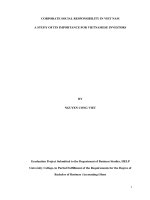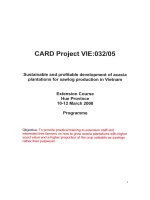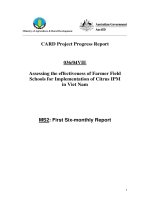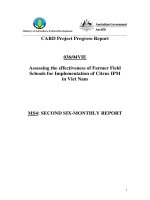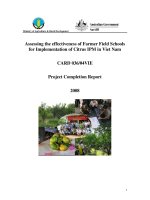Stutus of knowledge enabling environment in private eduacational companies in viet nam basic for enhancement program of knowledge management
Bạn đang xem bản rút gọn của tài liệu. Xem và tải ngay bản đầy đủ của tài liệu tại đây (1.07 MB, 184 trang )
STATUS OF KNOWLEDGE ENABLING ENVIRONMENT IN PRIVATE
EDUCATIONAL COMPANIES IN VIETNAM: BASIS FOR
ENHANCEMENT PROGRAM OF
KNOWLEDGE MANAGEMENT
___________________________
A DISSERTATION
Presented to the Faculty of the Graduate School
Southern Luzon State University, Lucban, Quezon, Philippines
in Collaboration with
Thai Nguyen University, Socialist Republic of Vietnam
___________________________
In Partial Fulfillment
of the Requirements for the Degree
Doctor of Philosophy in Educational Management
___________________________
By
LE THU HANG (MOON)
August 2014
i
APPROVAL SHEET
The Dissertation of
LE THU HANG
entitled
STATUS OF KNOWLEDGE ENABLING ENVIRONMENT IN PRIVATE
EDUCATIONAL COMPANIES IN VIETNAM: BASIS FOR
ENHANCEMENT PROGRAM OF KNOWLEDGE MANAGEMENT
Submitted in Partial Fulfilment of the Requirements for the Degree
DOCTOR OF PHILOSOPHY IN EDUCATIONAL MANAGEMENT
A program offered by Southern Luzon State University,
Republic of the Philippines in collaboration with
Thai Nguyen University, Socialist Republic of Vietnam
has been approved by Oral Examination Committee
TERESITA V. DELA CRUZ, EdD
Expert
APOLONIA A. ESPINOSA, PhD
Expert
LEONISA O. BERNARDO, PhD
Expert
BELLA R. MUELLO, PhD
External Panel
WALBERTO A. MACARAAN, EdD
Chairman
Endorsed by:
Recommended by:
CECILIA N. GASCON, PhD
Adviser
SUSANA A. SALVACION, PhD
Dean
Accepted in Partial Fulfilment of the Requirements for the Degree
Doctor of Business Administration
_____________________
Date
WALBERTO A. MACARAAN, EdD
Vice President for Academic Affairs
ii
CERTIFICATE OF ORIGINALITY
This is to certify that the research work /dissertation entitled STATUS
OF
KNOWLEDGE
ENABLING
ENVIRONMENT
IN
PRIVATE
EDUCATIONAL COMPANIES IN VIETNAM: BASIS FOR ENHANCEMENT
PROGRAM OF KNOWLEDGE MANAGEMENT, orally defended / presented
under the Doctor of Philosophy in Educational Management Program jointly
offered by Southern Luzon State University of the Republic of the Philippines
and Thai Nguyen University of the Socialist Republic of Vietnam, embodies
the result of original and scholarly work carried out by the undersigned.
This dissertation does not contain words or ideas taken from published
sources or written works by other persons which have been accepted as basis
for the award of any degree from other higher education institutions, except
where proper referencing and acknowledgement were made.
LE THU HANG
Researcher
Date Orally Defended:June 27th, 2014
iii
ACKNOWLEDGMENT
The author is most grateful to her adviser and Professor, Dr. Cecilia N.
Gascon, for her valuable academic and moral support, which she shall never
forget, during the doctoral program in education management of Southern
Luzon State University of the Philippines. She also highly appreciates the very
helpful suggestions made by Prof. Dr. Dang QuocBao about the research at
an early stage in its development.
She wishes to record my particular thanks to Teresita V. Dela Cruz,
Apolonia A. Espinosa and Walberto A. Macaraan,Bella R. Muello, Southern
Luzon State University, for their constructive and useful pieces of advice to
improve the dissertation.
While collecting data for this research, she was lucky enough to
receive support from a number of colleagues and friends of EduTrust and
Vietnam Chamber of Commerce and Industry in Hanoi and Ho Chi Minh City.
At the EduTrust, thanks are due to colleagues of the office of the Chairman.
Vietnam Chamber of Commerce and Industry, special thanks go to Le Thuy,
Project Director.
In addition, she indebted to leaders and staff of Thai Nguyen
University, of ITC for their enthusiastic support during the program as well as
to Dr. Judith Narrowe and Dr.Bertil Olsson, Dalarna University, Sweden, for
their moral support at the most difficult moments.
Also, she would like to express her gratitude to all interviewees and
group discussants who took the time to share their lives and thinking with
iv
herand thus enriched her understanding of the problems to which this
dissertation addresses itself.
Last but not least, she dedicates this work to her family members, with
thanks for all they have done for her over the years.
Le Thu Hang (Moon)
v
DEDICATION
To My Friends & Family
Thank you for ALL the Support
LTH
vi
TABLE OF CONTENTS
PAGE
TITLE PAGE ………………………………………………………………..
i
APPROVAL SHEET ……………………………………………………….
ii
CERTIFICATE OF ORIGINALITY ………………………………………..
iii
ACKNOWLEDGEMENT …………………………………………………..
iv
DEDICATION ………………………………………………………………
vi
TABLE OF CONTENTS …………………………………………………..
vii
LIST OF TABLES ………………………………………………………….
ix
LIST OF FIGURES ………………………………………………………...
xi
LIST OF APPENDICES …………………………………………………...
xii
ABSTRACT …………………………………………………………………
xiv
CHAPTER
I
II
III
INTRODUCTION
Introduction ………………………………………………….
1
Background of the Study …………………………………..
3
Objectives of the Study….………………………………….
5
Significance of the Study …………………………………..
6
Scope and Limitation of the Study ………………………..
6
Definition of Terms ………………………………………….
7
REVIEW OF LITERATURE AND STUDIES
Review of Literature ….....…………………….……………
16
Conceptual Framework ………………………………..…..
29
Research Paradigm ………...………………………………
51
METHODOLOGY
Locale of the Study …………………………………………
52
Research Design ……………………………………………
52
Population and Sampling ………….……………………….
54
Research Instrumentation …………………………..….….
56
Data Gathering Procedures ……….………........…………
58
vii
Statistical Treatment. ……………………………………….
63
IV
RESULTS AND DISCUSSIONS ………………………….
67
V
SUMMARY OF FINDINGS, CONCLUSIONS AND
RECOMMENDATIONS
Summary ……………….……………………………………
94
Conclusions …………………………………………………
101
Recommendations …………………………………………
102
REFERENCES ……………………………………………………………..
104
APPENDICES ……………………………………………………………...
112
CURRICULUM VITAE …………………………………………………….
168
viii
LIST OF TABLES
TABLE
1
PAGE
Summary of the Aspects within Human Resources and its
Management
31
Summary of the Aspects within the Communication
Activities of the Company
39
Summary of the Aspects within the Information Technology
Infrastructure
42
4
Summary of the Aspects of the Learning Arenas
44
5
Summary of the Aspects of the Use of Knowledge
48
6
Number of Employees per Company and Contract
Arrangements
68
Frequency of the Methods for Advertising Available
Positions
70
7b
Frequency of the Method of Selecting Employees
71
7c
Frequency of the Different Selection Criteria
71
8
Aspects within Employee Turnover
74
9
Bonus System
75
Number of Companies by Frequency of the General
Information Meeting by Sector
76
Number of Companies by Scheduled Meetings of
Professional Workers and Sectors
76
10c
Companies with Newsletter by Sector
77
10d
Number of Companies by Person in the Gatekeeper
Position and Sector
77
Number of Hour Formal and Informal Meetings (Cells
Refers to Percentage of Respondents)
78
11
Information Technology Infrastructure
80
12
Pearson Correlations of the Knowledge Enabling
81
2
3
7a
10a
10b
10e
ix
TABLE
13
14
15
16
17
PAGE
Constructs
Bivariate Pearson Correlation between Construct Scales
and Effective Measurements
83
Bivariate Pearson Correlation of KnowledgeCreating
Indicators
87
Bivariate Pearson Correlation between Knowledge
Enabling Constructs and KnowledgeCreation Indicators
88
Pearson Correlation among Knowledge Creation and
Effectiveness Indicators
90
Summary of explicit plan of knowledge management
92
x
LIST OF FIGURES
FIGURE
PAGE
1
Knowledge Management and Lifelong Learning
17
2
Knowledge Management Activities
27
3
Conceptual Framework for Knowledge Management in
SMEs
29
4
Research Paradigm
51
xi
LIST OF APPENDICES
APPENDIX
PAGE
A
Communication Letters
113
B
Interview and Document Data
115
C
Descriptive Statistics
130
Number of Employees per Company and Contract
Arrangements
130
Number of Employees per Company and Type of
Professional Role (Professional, Supports or Leaders)
131
Number of Employees per Company and Contract
Arrangements
132
Number of Respondents by Educational Attainment as a
Percentage of All Respondents
133
Table 5
Number of Tiers and Work Organization
134
Table 6
Recruitment and Selection Aspects
135
Table 7
Aspects Related with New Recruitments
137
Table 8
Aspects within Employee Turnover
138
Table 9
Criteria to Determine Salaries
139
Table 10
Company Salary Level
140
Table 11
Bonus System
141
Table 12
Aspects within the Communication Activities
142
Table 13
Number of Hour Formal and Informal Meetings (Cells
Refers to Percentage of Respondents)
144
Respondent’s Perceived Usefulness of Formal and
Informal Meetings
145
Distribution of Information (Cells refer to Percentage of
Respondents)
146
Information Technology Infrastructure
147
Table 1
Table 2
Table 3
Table 4
Table 14
Table 15
Table 16
xii
Table 17
Workforce Stability Indicators
148
Table 18
Bivariate Pearson Correlations of the Binary Recoded
Indicators of the Stability Construct in the Selected
Companies (above 0.4)
149
Table 19
Workforce Experience Indicators
150
Table 20
Professionalism Indicators
151
Table 21
Bivariate Pearson Correlation of the Binary Recoded
Indicators of the Professionalism Construct in the
Selected Companies(above 0.3)
152
Table 22
Recruitment Policy Indicators
153
Table 23
Company Monetary Reward System Indicators
154
Table 24
Bivariate Pearson Correlation of the Binary Recoded
Indicators of the Monetary Reward Aspect Construct in
the Selected Companies (above 0.4)
155
Table 25
Communication Patterns Indicators by Company
156
Table 26
Information Technology Infrastructure Indicators by
Company
157
Bivariate Pearson Correlation of the Binary Recoded
Indicators of the Information Technology Investment
Binary Indicators (Above 0.4)
158
Table 28
ANOVA of Course Length by Sector
159
Table 29
ANOVA of Course Training Cost By Sector
160
Table 30
Number of Training Events and Yearly Estimated
Training Time by Purpose of Training and Company
161
Average Scores and Standard Deviations of the Informal
Learning Items by Company
164
Total Variance Explained by the Factor Analysis of the
Knowledge Creation Indicators
165
Total Variance Explained by the Factor Analysis of the
Knowledge Creation Indicators
166
Bivariate Pearson Correlation between Knowledge
Enabling Construct and Knowledge Creation Indicators in
Each Service
167
Table 27
Table 31
Table 32
Table 33
Table 34
xiii
ABSTRACT
Title of Research
: STATUS OF KNOWLEDGE ENABLING
ENVIRONMENT IN PRIVATE EDUCATIONAL
COMPANIES IN VIETNAM: BASIS FOR
ENHANCEMENT PROGRAM OF KNOWLEDGE
MANAGEMENT
Researcher
: LE THU HANG (MOON)
Degree Conferred
: DOCTOR OF PHILOSOPHY IN EDUCATIONAL
MANAGEMENT
Name and Address
of Institution
: Southern Luzon State University Lucban, Quezon,
Philippines and Thai Nguyen University, Socialist
Republic of Vietnam
Adviser
: Dr. Cecilia N. Gascon
Year Written
: 2013– 2014
______________________________________________________________
The dissertation is an exploration of the ways Vietnamese knowledge
intensive companies manage their knowledge. By doing analysis in private
educational Vietnamese companies providing educational and consultancy
services, the study explores the relationship between the knowledge enabling
environment and the demand for training. These companies have participated
in the program for developing employee competence, financed by the Asian
Development Bank. As results of the program these companies have
evaluated their business activities and determined their training needs in order
to remain competitive.
In this study, knowledge is understood not only the structure but also
the content of mental schemas, which embodies in individuals and can be
tacit or explicit. It really differs from information and data and it is through the
dialectic process that people learn. Looking at organizational processes for
xiv
managing knowledge, it is important to consider formal organized activities for
learning as well as informal learning activities which constitute so called
“knowledge enabling environment”. It is argued here that through knowledge
management, companies are indeed implementing strategies for the
promotion of lifelong learning, which has recently been used in policy arena
as a guiding principle for educational policies and reforms.
As results of the study, the different aspects of the equally
heterogenous “knowledge enabling environment” do not present strong
relationships in both education and consultancy companies. Each company in
those fields is rather unique in organization and promotion of knowledge
intensity in their ordinary business activities. The companies mainly provide
training with the company profile. It is interesting to find out that employees
demand for training if their engagement in informal learning is low.
xv
1
Chapter I
INTRODUCTION
According to the World Bank, the competitiveness index of human
resources in Vietnam reached 3.39/10 point and competitiveness of Vietnam
economy reached 73/133 among participated countries.
Furthermore, the recent social survey showed that the capital scale of
enterprises is rather small. Nearly 50% of businesses have their capital less
than 1 billion VND. While nearly 75% of enterprises with capital of less than 2
billion VND, 90% of enterprises have their capital of less than 5 billion VND.
Due to the small capital scale, enterprises of Vietnam seem to be less
competitive. The innovation and technology of enterprises are critical.
Concerning human resources in small and medium enterprises
(SMEs), the number of PhDs accounted for only 0.66% while masters
composed of 2.33%; labor graduated from universities and colleges as
41.38% while graduators of vocational schools as 12.33%.
It is noteworthy that a part of business owners who got their education
from colleges and universities are not equipped with knowledge of economy,
business administration and human resource management. This has a great
influence
on
the
development
of
strategic
planning,
direction
and
management of business enterprises. Regarding technology, only about 8%
of enterprises reached advanced level of technology. Most of them are FDI
enterprises.
2
Domestic enterprises are using less competitive technology. In
addition, the indicator on ICT use also showed that though businesses (more
than 60%) use computers but only 11.55% use internal network - LAN and
2.16% with own websites. It is really critical for ability of enterprises to
participate in electronic commerce and communication network as expected
and desired by the government. It showed that technical issues, technology
and innovation have not been highly considered by enterprises, which is one
of determining factors of business success in the market.
To serve the cause of industrialization and modernization of the
country and to foster significant participation in globalization, important legal
documents have been issued, especially the economic and social
development strategy of 2011-2020 including the Resolution on Vietnam
Workforce Development to the year 2020 adopted at the 11th Party Congress
(April, 2011). Following the Resolution are the Decision No. 579/QD-TTg of
strategy on human resource development approved by the Prime Minister on
April 19, 2011 and the Decision 1216/QD-TTg of planning on Vietnam human
resource development for 2011-2020 approved by the Prime Minister on July
22, 2011.
According to those documents, in the next ten years, it should increase
the rate of trained human resource in the economy with reasonable structure.
The total number of trained manpower in 2015 is expected to be about 30.5
million people and in 2020, there will be nearly 44 million people (representing
approximately 70.0% of the nearly 63 million people employed in the
economy).
3
From the total number of trained manpower, the number of trained
personnel through vocational training system in 2015 is expected to reach
23.5 million (by 77%) and in 2020 - about 34.4 million people (by 78.5%); the
number through the education and training system in 2015 accounts for
approximately 7 million people (by 23%) and in 2020 approximately 9.4 million
people (by 21.5%).
Background of the Study
In the context of knowledge economy, a lot of workshops and
conferences on knowledge management have been held recently in many
sectors of Vietnamese economy, both public and private ones.
The major comments have been largely agreed that many businesses
in Vietnam are now just focusing on the issues such as production, cost
reduction while leaving behind the issue of knowledge management, which
can support leadership to solve business problems. For example, when a
company faces a brain drain, business is interrupted or affected at least until a
matching replacement is found.
However, the situation could have been avoided if companies perform
well the task of knowledge management, which is implemented by collection,
storage, sharing and use of information and trade secrets, not only at
individual levels but at the level of the enterprise. Then a mechanism and a
process of creation, storage, sharing and development of knowledge in each
business are required so that the knowledge of individual turns into
knowledge assets of the enterprise. Take a look at another example where a
4
business leader needs to make a quick business decision. In the case the
department of business development can assist the board of directors in
strategic insights on commercial viability, in consideration of risks and
competitors, in analysis of strengths and weaknesses as well as necessary
financial resources. The above mentioned department plays here the role of a
unit of knowledge management with comprehensive information and accurate
business lines as well as the knowledge enabling environment. It is
noteworthy that to promote knowledge efficiency, a few training sessions to
transfer knowledge to staff is not enough.
Some factors that contribute to the success of knowledge management
have been listed in the workshops and conferences mentioned above: (1) the
relationship between knowledge and business effectiveness; (2) proper
system and infrastructure (data storage, information exchange, knowledge
transfer to users…); (3) experts on knowledge management to support both
leaders and employees.
From the early 1980s knowledge management was typically associated
with the use of information technology, knowledge based systems, portals and
data repositories in companies. Starting around the year 2000, knowledge
management has grown to become an integral part of basic management,
especially in knowledge intensive organizations and in non-IT related
organizational processes.
In
this
incarnation,
knowledge
management
integrates
all
organizational processes that are directed towards knowledge creation and
use, and information distribution and storage. Despite the central role that
5
knowledge creation plays in knowledge management, few references to
educational science and learning can be found. Therefore exploring how
knowledge management is related to training activities in organizations is an
interesting and useful endeavor.
As studies within the area of human capital theory have found that
small companies face more problems in providing training opportunities to
their employees than large companies.
In addition, it has been found that certain company and work
characteristics, such as size of the company, and literacy practices at work,
are associated with higher levels of training participations. Thus, it seems
particularly interesting to explore the relationship between the way small and
medium organizations manage their knowledge and their demand for training.
Objectives of the Study
The main objectives of the study are to analyze the knowledge
enabling environment in selected companies in education and consultancy.
Specifically, this sought to:
1. Identify the instructional variables that influence the knowledge
enabling environment and knowledge management in selected
companies in education and consultancy
2. Determine the significant relationship between the company’s
perceived needs for continuous competence development and the
company’s demand for training
6
3. Analyze the enhancement program of knowledge management that
can be proposed from the results of the study.
Significance of the study
This study would be beneficial to the following:
Administrators and leaders. It is hoped that the study may contribute
in giving a new dimension in knowledge management. The study would
provide administrators and leaders with a clear idea and model of knowledge
management. In the same manner, their practice of knowledge management
could give a fresh perfective in terms of its influence to the overall SMEs in
education and consultancy.
Future Researchers. This study could provide references for future
proponents who wish to venture a study similar to the nature of this ongoing
research. Thus, basic tenets on knowledge management and novel
dimensions on instructional variables could serve as resources for other
studies.
Scope and Limitation of the Study
The study is limited to private educational companies that provide a
rich amount of information and constitute interesting cases for the purpose of
the dissertation. They are small and medium private Vietnamese companies
that work within two services that can be considered “knowledge intensive”
consultancy and education.
7
The companies are a self-selected sample of a very particular kind. All
the
companies
have
applied
and
received
grants
for
competence
development. This provided an opportunity to gain access to specific
information on the demand for training that would be very difficult to obtain in
any other sample.
However, from initial group of 119 companies agreed to participate in
this study, only 18 companies provided a satisfactory amount of information
for the case study in the end. Thus, it is important to note that the results of
this study can only be generalized with caution to other small knowledge
intensive enterprises. The two services under study present different gender
balances, which might affect the way companies approach knowledge
management, although this has not been taken up in the study.
Definition of Terms
For clarity and better understanding of this study, the following terms
were hereby defined conceptually and operationally:
Collaborative Climate Index. The organization’s ability to transfer knowledge
from one unit to another in a collaborative manner has been found to
contribute to the organizational performance of companies in both the
manufacturing and service sectors. The benefits of knowledge sharing
have been documented in many settings, but the effectiveness varies
considerably among organizations. It is presented in the so called
Collaborative Climate Index (CCI).
8
Communication. The activity of conveying information through the exchange
of thoughts, messages, or information, as by speech, visuals, signals,
written, or behavior. It is the meaningful exchange of information
between two or more living creatures. Communication may be
intentional or unintentional, may involve conventional or unconventional
signals, may take linguistic or non-linguistic forms, and may occur
through spoken or other modes. Communication requires a sender,
a message, and a recipient, although the receiver does not have to be
present or aware of the sender's intent to communicate at the time of
communication; thus communication can occur across vast distances
in time and space. Communication requires that the communicating
parties
share
an
area
of
communicative
commonality.
The
communication process is complete once the receiver understands the
sender's message.
Company Size. Personnel number or employees margin of company.
Besides company size can be considered on industry, ownership
structure and revenue.
Dependent Variable. Variables used in an experiment or modeling can be
divided into three types and dependent variable is one of them.
Dependent variables represent the output or effect or is tested to see if
it is the effect. In a scientific experiment, you cannot have a dependent
variable without an independent variable.
Independent Variable. Variables used in an experiment or modelling can be
divided into three types: dependent variable, independent variable, or
9
other. Independent variables represent the inputs or causes, or are
tested to see if they are the cause.
Information
Technology
(IT).
The
application
of
computers
and
telecommunications equipment to store, retrieve, transmit and
manipulate data, often in the context of a business or other enterprise.
The term is commonly used as a synonym for computers and computer
networks, but it also encompasses other information distribution
technologies such as television and telephones. Several industries are
associated with information technology, including computer hardware,
software, electronics, semi-conductors, internet, telecom-equipment, ecommerce and computer services.
Innovation. The application of better solutions that meet new requirements,
in-articulated needs, or existing market needs. This is accomplished
through more effective products, processes, services, technologies or
ideas that are readily available to markets, governments and societies.
The term innovation can be defined as something original and, as a
consequence, new, that "breaks into" the market or society.
Knowledge. Knowledge is in people’s heads, it differs from information or
data, it is individual, and in some instances it can be made public or
shared as information. In addition, the difference between various
types of knowledge has been explained in terms of content. Andriessen
(2004, p. 97) identifies six different metaphors in his analysis of the
treatment of knowledge in key publications of the knowledge
management field: knowledge as something physical, as a wave, as a
10
living organism, as thought and feelings, as a process and as a
structure.
In the present work, knowledge is understood both as the
structure and the content of the mental schemas. Therefore, this study
uses knowledge as “something physical” and “as a structure” as
defined by Andriessen. It also includes the idea of knowledge as
feelings since the schemas have important emotional components.
Further, it includes knowledge as a process, as a wave and as a living
organism, since these three elements refer to the idea that knowledge
is in a constant dialectic process with the reality it represents. The
frame and the content are reinforced or change in each action that we
perform. It is through action that we test our schema in the real world.
This action will inform us about the schema that in tum will or will not
change. In this way, action develops our knowledge, and knowledge is
therefore a dynamic entity. Knowledge as a static entity never changes.
The optimistic view of science maintains that scientific inquiry looks for
objective and universal knowledge, what traditionally has been called
Truth with a capital T. However, post-optimistic views criticize the idea
of a universal truth and propose the existence of different truths. Thus,
there is no unique, invariant knowledge but different types of
knowledge viewed from different perspectives.
The dynamic feature of knowledge is thus related to the idea
that knowledge must be translated into and associated with action
(Elkjaer, 2003; Hunt, 2003). Further, the action uses knowledge but
does not “consume” the knowledge that can be re-used in its modified


